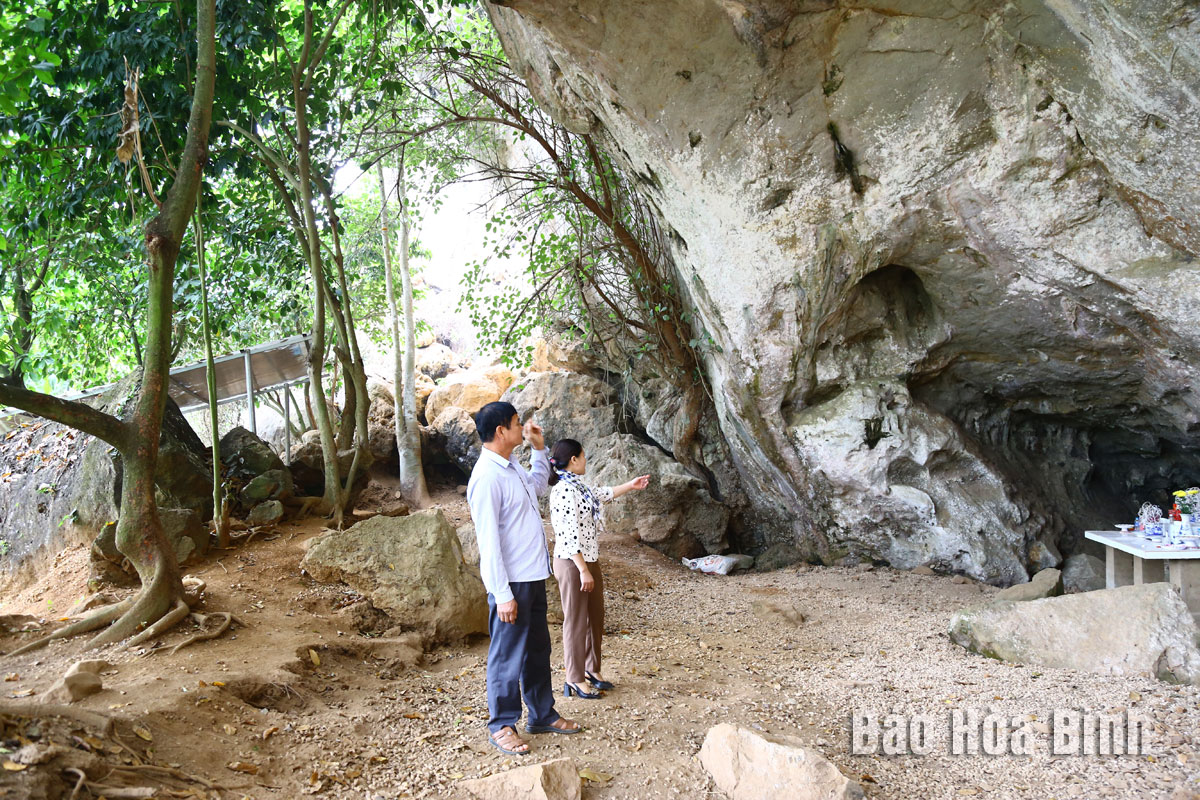
Holding unique values representing the world-famous Hoa Binh Civilisation, the archaeological sites of Trai Hamlet Cave and Vanh Village Stone Shelter in Lac Son district were recognised as special national relic sites in July.
Local residents have paid attention to protecting
natural landscape and environment around special national relic site of Vanh
Village Stone Shelter in Yen Phu commune, Lac Son district.
Exploring
Trai Hamlet Cave, Vanh Village Stone Shelter
Trai Hamlet Cave is located on a separate
limestone mountain, 15m above a nearby valley. It is more than 13m deep and has
an entrance 8m wide and 10m high. It contains food traces of early humans,
mainly stream and mountain snails. Statistics show that there are more than
30,000 shells per cubic metre of sediment inside this cave. Archaeologists have
found a substantial number of animal bone pieces here. Analyses indicate that
these are bones of animals living in the surrounding environment that early
humans caught for food. Rice husks and some half-burned grains have also been
discovered at a depth of 0 - 80cm underground, and they could belong to later
periods. This cave was listed as a national historical relic site in 2001.
Not far from Trai Hamlet Cave, Vanh Village
Stone Shelter is located at the foot of Da Trang (White Stone) Mountain in Vanh
village of Yen Phu commune. It is a relatively large stone shelter which is 18m
deep and has a 30m-wide entrance. It is about 5m higher than the surrounding
valley. The site was discovered and excavated by M. Colani in 1929 and also
named by the French archaeologist. Excavations at this place have revealed a
3.7m-thick cultural layer that contains mainly snails, clay, ashes, and mollusc
shells. Stone objects, human and animal bone pieces, horns, ceramic items,
stoves, and snail shells have also been found here. The shelter was named a
national historical relic site in 2003.
Promoting
relic sites’ values
Given their precious values, the two national
archaeological relic sites were recognised as special ones on July 18, 2024.
Bui Van Hung, head of the culture and
information division of Lac Son district, said that home to the two
archaeological relic sites typical for the prehistoric Hoa Binh Civilisation,
Lac Son has continually paid attention to the management, protection,
preservation, and promotion of the sites’ values. It is stepping up
communications about the places’ significance and values among the entire local
population so as to attract the public’s support for protecting the surrounding
landscape and environment. Tourism, learning, and scientific research
activities connected with the sites are also being promoted.
In the time ahead, to bring into full play the
values of these two special national relic sites, local authorities will
continue to seriously carry out management and protection activities in line
with the Law on Cultural Heritage, devise appropriate policies to encourage and
create conditions for people and businesses to engage in relic protection and
tourism development, and build new roads to connect arteries with the two
sites.
Additionally, the district will propose relic
management and rehabilitation measures to higher-level authorities in an effort
to become a destination on the tourism maps of Hoa Binh province, the region, and
the country, he added.
Phong Phu commune, Tan Lac district of Hoa Binh province, is widely regarded as the cultural heartland of the Muong ethnic group. Among its many traditional communities, Luy Ai hamlet (formerly Ai hamlet) stands out as a rare location where the customs and way of life of the Muong Bi people remain largely intact.
The Truong Kha temple festival, a distinctive cultural event held every three years in Vu Ban township, Lac Son district, returned recently with vibrant rituals and folk traditions of the Muong people. Located next to the Buoi River in the Muong Trao fields, the Truong Kha Temple is dedicated to the three Kun Dol deities, revered for teaching farming techniques, irrigation, weaving, and protecting the harvest.
The demand for spaces serving community activities of residents in various areas across Hoa Binh city has been satisfied as local cultural houses now feature modern, spacious facilities thanks to the effective implementation of Resolution No. 49/NQ-HDND issued on December 28, 2021 by the city People's Council, which approved the plan for reorganising, converting, and allocating land for the construction, repair, and expansion of cultural houses in Hoa Binh’s villages and residential areas until 2025.
At the end of May, the Hoa Binh Provincial Ethnic Arts Troupe organized a series of performances for residents in Region 2 and Region 3 communes across the province. Bringing art to ethnic communities in remote, isolated, and especially disadvantaged areas has become a meaningful activity. These are not merely artistic performances but also journeys to disseminate cultural values, enrich spiritual life, and contribute to preserving the cultural identity of ethnic minorities.



